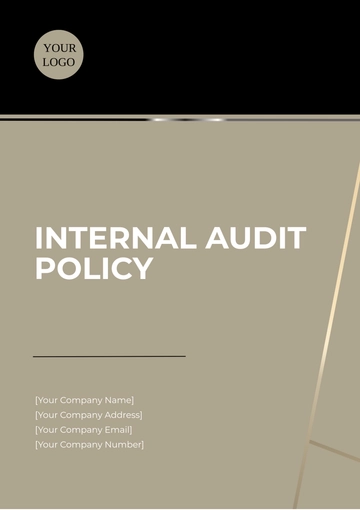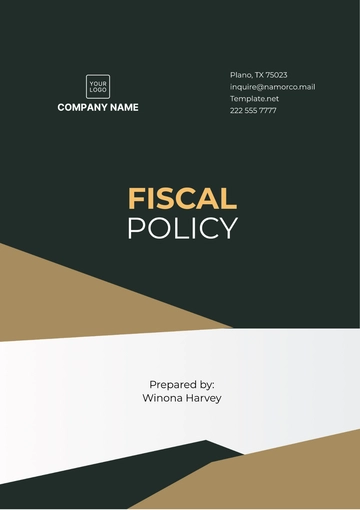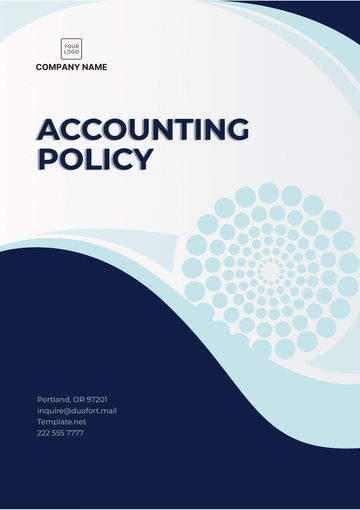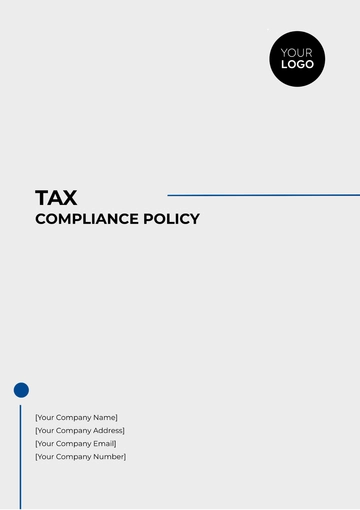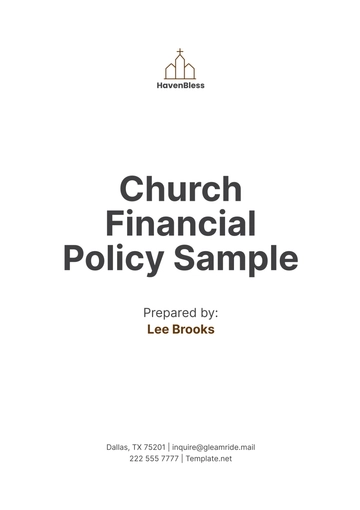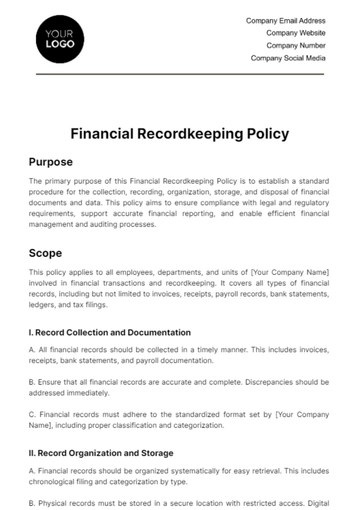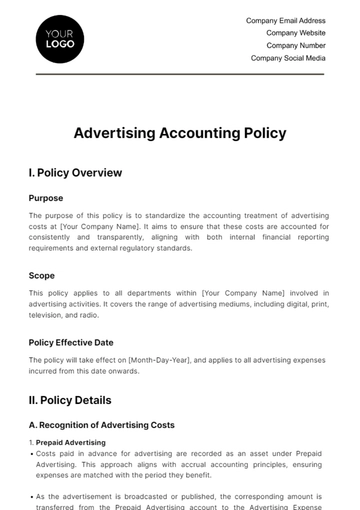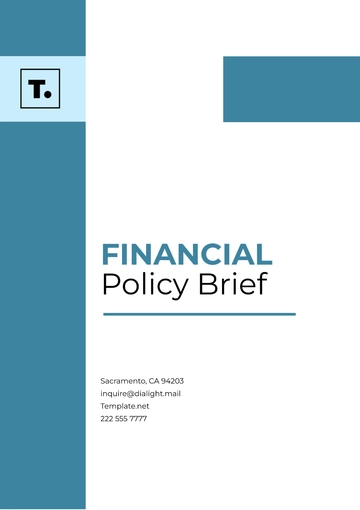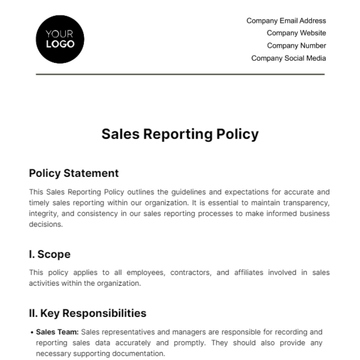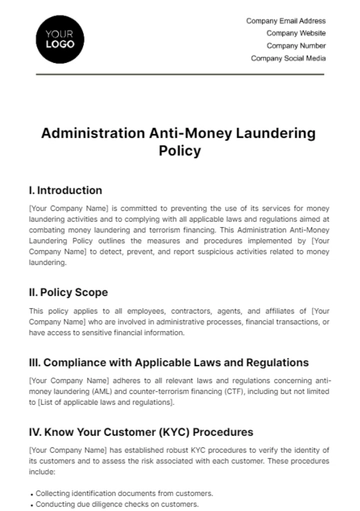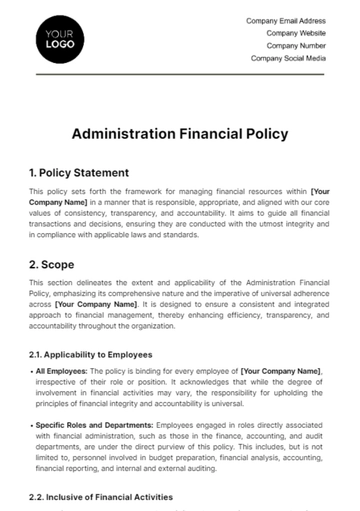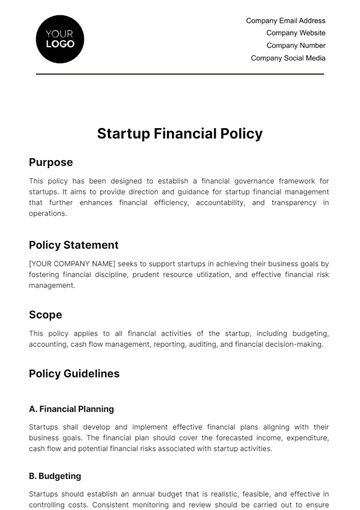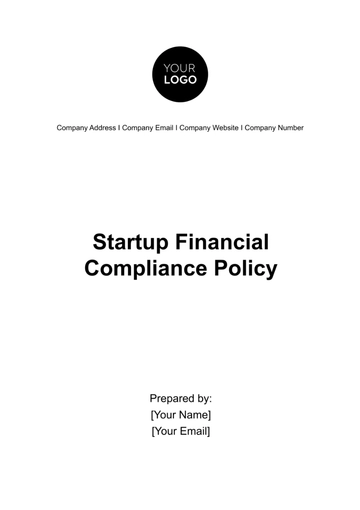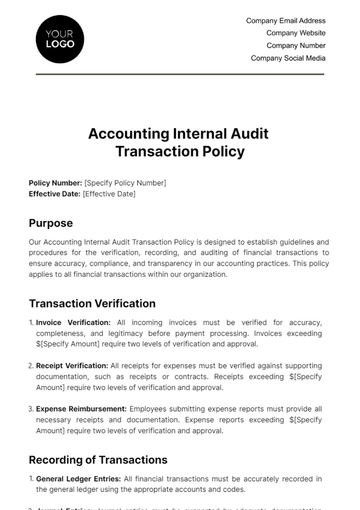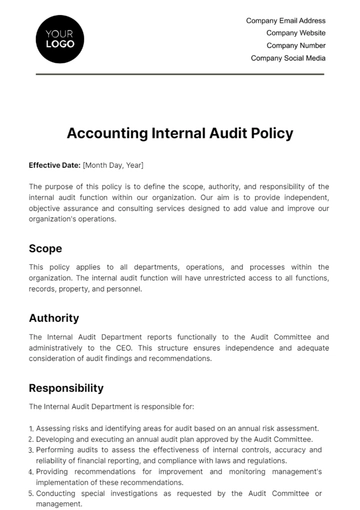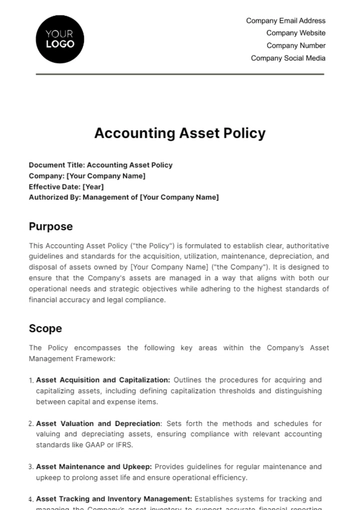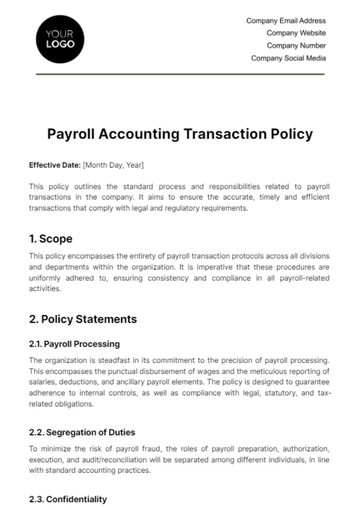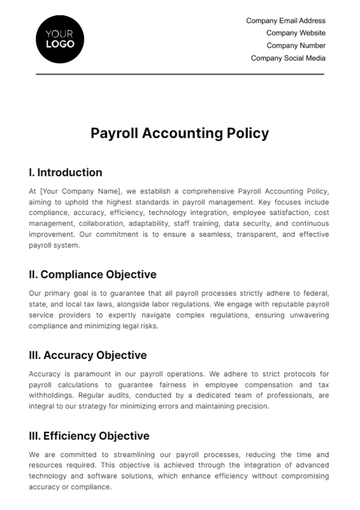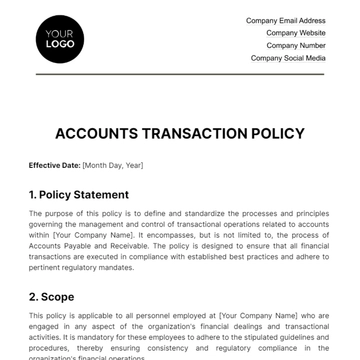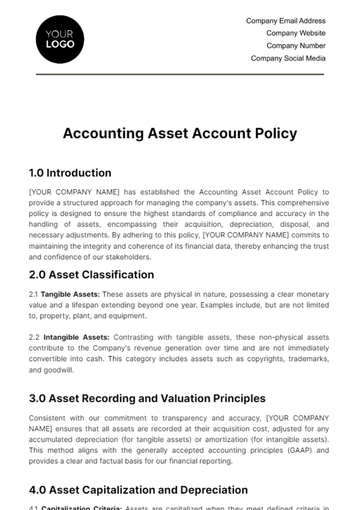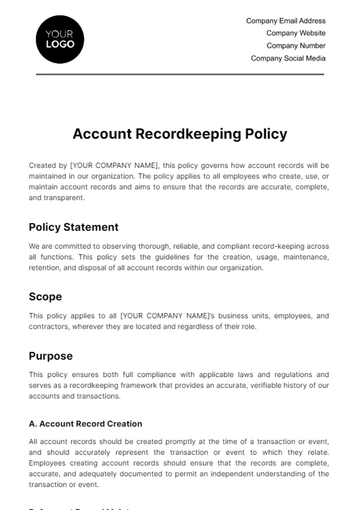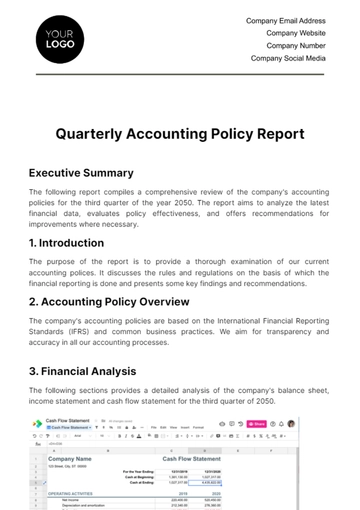Free Financial Policy Portfolio

Introduction and Objectives
This portfolio presents the comprehensive financial policies and procedures for [Your Company Name]. It is designed to provide guidance on the management of financial resources to ensure legal compliance, transparency, and accountability.
The main objectives of this portfolio are to enhance financial discipline, promote effective control of financial activities, and facilitate the accomplishment of the company's strategic goals.
Budgeting and Planning
The Budgeting and Planning section is integral to financial management, focusing on creating, reviewing, and approving the organization's financial roadmap. This procedure ensures financial resources are allocated efficiently, aligning with strategic goals and maintaining compliance with financial standards. It encompasses both annual budget cycles and long-term financial planning.
Budget Preparation ↓ Review and Analysis ↓ Consolidation ↓ Senior Management Review ↓ Board Approval ↓ Implementation and Monitoring |
Revenue Recognition and Management
The Revenue Recognition and Management section of the Financial Policy Portfolio is fundamental in maintaining the integrity and accuracy of financial reporting. Adherence to these policies ensures compliance with US legal standards and Generally Accepted Accounting Principles (GAAP). Our policies aim to provide clear guidelines for recognizing, recording, and managing revenue, thus ensuring transparency and consistency in our financial processes.
Policy on Sale of Goods and Services
Recognition Criteria: Revenue from the sale of goods and services is recognized when control of the goods or services is transferred to the customer, and the amount of revenue can be reliably measured.
Measurement of Revenue: Revenue is measured at the fair value of the consideration received, net of returns, trade discounts, and volume rebates.
Disclosure Requirements: Comprehensive disclosures are provided in financial statements, detailing the nature, amount, timing, and uncertainty of revenue and cash flows.
Policy on Contract-Based Revenue
Contract Identification: Each contract with a customer is assessed to identify performance obligations.
Transaction Price Allocation: The transaction price is allocated to each distinct performance obligation and recognized as revenue when or as the obligation is satisfied.
Contract Modifications: Any modifications to contracts are evaluated to determine if they require a change in the revenue recognition pattern.
Policy on Revenue from Interest and Dividends
Interest Revenue Recognition: Interest income is recognized using the effective interest method, as set forth in the applicable financial reporting framework.
Dividend Revenue Recognition: Revenue from dividends is recognized when the right to receive payment is established.
Reporting and Compliance: Ensure regular review and compliance with the latest financial reporting standards and legal regulations related to interest and dividend income.
Expense and Payables Management
This section is dedicated to outlining the policies and procedures for efficient expense and payables management. It encompasses procurement processes, expense authorization, vendor management, and payment processing, ensuring practices align with financial controls and efficiency standards.
Aspect | Policy |
|---|---|
Procurement | Establish guidelines for procurement to ensure cost-effectiveness and compliance with company policies. Regular review and approval of procurement plans. |
Expense Authorization | Implement a systematic authorization process for expenses, ensuring alignment with budget and operational needs. |
Vendor Management | Develop and maintain relationships with vendors, including regular evaluations and adherence to contractual terms. |
Payment Processing | Ensure timely and accurate processing of payments, adhering to payment terms and internal controls for financial integrity. |
Asset Management
The Asset Management section details the organization’s approach to handling its assets. This includes policies for the acquisition, maintenance, depreciation, and disposal of assets, ensuring that these processes are managed effectively, comply with accounting standards, and contribute to the organization's long-term financial health.
Acquisition: Policies for purchasing or acquiring assets, focusing on cost-benefit analysis, budget compliance, and authorization processes.
Maintenance: Guidelines for regular upkeep and maintenance of assets to preserve their value and functionality.
Depreciation: Procedures for calculating and recording the depreciation of assets in line with accounting standards.
Disposal: Policies for the disposal or sale of assets, including criteria for deciding when to dispose and methods to ensure compliance with legal and environmental regulations.
Liabilities and Debt Management
The Liabilities and Debt Management section of our Financial Policy Portfolio establishes stringent policies to manage and control liabilities and debts effectively. Adherence to these guidelines is crucial for maintaining our organization's creditworthiness and ensuring long-term financial stability. Our policies are designed to align with US financial regulations and best practices, ensuring prudent debt management.
Policy on Borrowing and Credit Limits
Borrowing Guidelines: Borrowing is restricted to approved purposes and within set credit limits.
Credit Limit Adherence: Regular monitoring to ensure compliance with established credit limits.
Policy on Debt Servicing and Repayment
Debt Servicing Compliance: Ensures timely payment of interest and principal, maintaining good standing with creditors.
Repayment Schedule Adherence: Strict adherence to agreed-upon repayment schedules to avoid penalties and maintain credibility.
Policy on Debt Monitoring and Reporting
Regular Debt Review: Periodic assessment of the debt portfolio to manage risks and optimize the debt structure.
Transparent Reporting: Detailed and regular reporting of the debt position, servicing, and repayment in financial statements.
Internal Controls and Audit
The Internal Controls and Audit section is a cornerstone of our financial governance, designed to mitigate risks related to fraud and errors while ensuring compliance with regulatory standards. These policies fortify our commitment to financial integrity and accountability, critical for maintaining stakeholder trust and legal compliance.
Policy on Internal Control Framework
Implementation of Controls: Implement and maintain robust internal controls across all financial processes.
Regular Review and Update: Periodically review and update controls to address emerging risks and changes in business operations.
Policy on Internal Auditing
Audit Planning and Execution: Conduct regular internal audits to assess the effectiveness of financial controls and procedures.
Reporting and Follow-Up: Ensure findings are reported to management and corrective actions are implemented in a timely manner.
Policy on External Audit Compliance
Coordination with External Auditors: Collaborate with external auditors for annual audits and ensure readiness for such audits.
Adherence to Audit Recommendations: Implement recommendations from external audits to continuously improve financial practices.
Risk Management and Compliance
Our Risk Management and Compliance policies play a crucial role in proactively identifying, assessing, and mitigating financial risks. This ensures the safeguarding of organizational assets and reputation. These policies are tailored to align with financial laws and regulations, providing a comprehensive framework for managing potential risks effectively.
Financial Risk Management
Identification and Assessment: Systematically identify and assess financial risks, including market, credit, and liquidity risks.
Mitigation Strategies: Develop and implement strategies to mitigate identified risks, including diversification, hedging, and insurance.
Regulatory Compliance
Compliance with Laws and Regulations: Regularly monitor and ensure compliance with all applicable financial laws and regulations.
Training and Awareness: Conduct ongoing training for staff to ensure awareness and understanding of compliance requirements.
Reporting and Documentation
This section outlines the organization's commitment to adhering to tax laws and regulations. It encompasses stringent policies for accurate and timely tax filing, ensuring compliance with federal, state, and local tax requirements. Procedures are in place for maintaining detailed financial records, calculating tax liabilities accurately, and submitting all required tax documentation. Additionally, the organization has established protocols for handling tax audits, which include prompt and transparent communication with tax authorities and providing necessary documentation. This comprehensive approach ensures full compliance with tax obligations and minimizes risks related to tax matters.
Policy Review and Amendments
The Policy Review and Amendments section is integral to ensuring that our financial policies remain dynamic and responsive to changing business environments and regulatory landscapes. Regular reviews and timely updates are fundamental to maintaining the relevance and effectiveness of our financial policies and procedures.
Periodic Review Process
Scheduled Reviews: Establish a regular schedule for reviewing financial policies and procedures.
Stakeholder Involvement: Engage relevant stakeholders in the review process to ensure comprehensive evaluation.
Amendment Procedures
Proposal and Approval of Changes: Outline a clear process for proposing, reviewing, and approving amendments to financial policies.
Documentation and Communication: Ensure all changes are well-documented and communicated effectively to all relevant parties.
- 100% Customizable, free editor
- Access 1 Million+ Templates, photo’s & graphics
- Download or share as a template
- Click and replace photos, graphics, text, backgrounds
- Resize, crop, AI write & more
- Access advanced editor
Discover the perfect solution for your financial governance needs with the Financial Policy Portfolio Template from Template.net. Fully editable and customizable, this template streamlines your policy management. Effortlessly editable in our Ai Editor Tool, ensuring a tailored fit for your organization's specific requirements.
You may also like
- HR Policy
- Restaurant Policy
- Company Policy
- Accounting Policies and Procedures
- Website Policy
- Privacy Policy
- Safety Policy
- School Policy
- IT and Software Policy
- Law Firm Policy
- Construction Policy
- Interior Design Policy
- Travel Agency Policy
- Education Academic Policy
- Security Policy
- Real Estate Policy
- Expense Policy
- Software Policy

